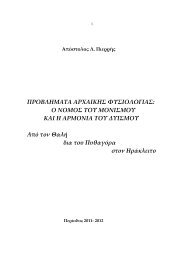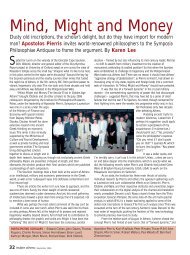chapter 10 the monism of darkness and the dualism of limit and ...
chapter 10 the monism of darkness and the dualism of limit and ...
chapter 10 the monism of darkness and the dualism of limit and ...
You also want an ePaper? Increase the reach of your titles
YUMPU automatically turns print PDFs into web optimized ePapers that Google loves.
72 CHAPTER <strong>10</strong><br />
appleÚÂÛ‚‡Ù·ÙfiÓ Ù ηd ·éÙÔÙÂÏÉ appleÔχÌËÙÈÓ òEÚˆÙ·<br />
¬Û· Ù’ öÊ˘ÛÂÓ ±apple·ÓÙ·, ‰È¤ÎÚÈı ‰’ ôÏÏÔ àapple’ ôÏÏÔ˘.<br />
Ophion <strong>and</strong> Eurynome, <strong>the</strong> first couple <strong>of</strong> cosmic domination<br />
according to Apollonius’ Orphic doctrine, correspond to <strong>the</strong> Orphic<br />
pairing (according to Hieronymus <strong>and</strong> Hellenicus) <strong>of</strong> Time-Serpent<br />
with Ananke or Adrasteia (Eurynomes extensive sovereignty indicates<br />
<strong>the</strong> inescapable inevitability <strong>of</strong> Necessity). Ophion <strong>and</strong> Eurynome<br />
represent <strong>the</strong> mythological formulation <strong>of</strong> <strong>the</strong> same reality that Time<br />
<strong>and</strong> Adrasteia=Necessity express in a more logico-mythical fashion.<br />
Apollonius’ summary divides Orphic <strong>the</strong>ological cosmogony in two<br />
parts, a physical (v. 496-502) <strong>and</strong> a mythical (v. 503-511) part, instead<br />
<strong>of</strong> combining <strong>and</strong> unifying both <strong>of</strong> <strong>the</strong>m (especially in <strong>the</strong> first phases<br />
<strong>of</strong> creation) into a coherent logico-mythical syn<strong>the</strong>sis symbolizing <strong>the</strong><br />
divine <strong>and</strong> physical aspects <strong>of</strong> <strong>the</strong> World simultaneously. - A<br />
connecting bridge between <strong>the</strong> Cosmogony <strong>of</strong> <strong>the</strong> Orphic<br />
Argonautica (419 sqq.) <strong>and</strong> that <strong>of</strong> Apollonius <strong>of</strong> Rhodes (A 496<br />
sqq.), is <strong>of</strong>fered by <strong>the</strong> detailed story in Ovid’s Metamorphoses I, 5<br />
sqq. Chaos comprises all <strong>the</strong> elements <strong>and</strong> parts <strong>of</strong> <strong>the</strong> World while<br />
<strong>the</strong>y are still formless <strong>and</strong> merge toge<strong>the</strong>r in an undifferentiated mass<br />
from which deus et melior natura distinguish <strong>and</strong> separate all total <strong>and</strong><br />
partial beings, thus articulating <strong>the</strong> system <strong>of</strong> World-Order, <strong>of</strong><br />
KfiÛÌÔ˜, according to <strong>the</strong> example <strong>of</strong> Apollonius’ Argonautica. This<br />
deus that is not mentioned in <strong>the</strong> synopsis <strong>of</strong> Orphic doctrines in<br />
Apollonius passages (but who should be certainly present in <strong>the</strong> full<br />
version <strong>of</strong> <strong>the</strong> summarized Cosmogony although he is replaced in <strong>the</strong><br />
abbreviation through philosophical influence by <strong>the</strong> Empedoclean<br />
Hate) is <strong>the</strong> Eros <strong>of</strong> <strong>the</strong> Orphic Argonautica 29 .<br />
9. Combining <strong>the</strong> Homeric geneological succession in <strong>the</strong> manner<br />
explained above with <strong>the</strong> Orphic cosmogonies starting with Time <strong>and</strong><br />
<strong>the</strong> Ophion-mentioning <strong>the</strong>ogonies, we reach <strong>the</strong> following<br />
correspondence:<br />
Homer Orphism Ophionic tradition according to<br />
Hieronymus <strong>and</strong> Hellanicus<br />
Ocean (Tethys) Time (Necessity) Ophioneus (Eurynome)










